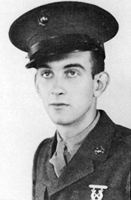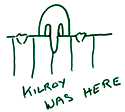The Stamford Historical Society Presents
Pride and Patriotism: Stamford’s Role in World War II
Online Edition
The Interviews – Special Edition
Chet Buttery
Chet Buttery enlisted in the Marine Corps immediately after his graduation from Stamford High School in 1944. He arrived in Saipan in the spring of the following year and, as member of the 5th Combat M.P. Battalion, was stationed there until 1946.
Chet Buttery in 2004 kindly gave the Society access to his papers, which include his war letters as transcribed by his grandfather and three scrapbooks/photo albums. Society volunteer Stuart Webster and Librarian Ron Marcus conducted an extenvise oral history interview, now existing both as transcript and as sound file. Stuart scanned all materials and created a CD containing all letters and images in PDF format, as well as the sound file of the interview. The CD may be viewed/listened to on the Society’s library computer on request.
 Before I went in, I figured I’d be over in the Pacific someplace, so I got a map out, and I wrote down a list of all the islands that I could find in the Pacific. I put a person’s name behind each one, so that when we went over, as we left pearl harbor, we landed on Guam, and that was our first stop. I wrote home that, oh I met George Malcolm the other day and we went over some old times about school and everything, had a great time together. There was no such person, naturally. They looked it up and found out that I was on Guam. Then, after a while, we left Guam and we went to Saipan. It’s a good thing that we didn’t change too many islands out there, because they would have gotten wise to me after a while …
Before I went in, I figured I’d be over in the Pacific someplace, so I got a map out, and I wrote down a list of all the islands that I could find in the Pacific. I put a person’s name behind each one, so that when we went over, as we left pearl harbor, we landed on Guam, and that was our first stop. I wrote home that, oh I met George Malcolm the other day and we went over some old times about school and everything, had a great time together. There was no such person, naturally. They looked it up and found out that I was on Guam. Then, after a while, we left Guam and we went to Saipan. It’s a good thing that we didn’t change too many islands out there, because they would have gotten wise to me after a while …
They [blocks of TNT] were about one pound, about two inches long and four inches square, and had a fuse in it. We were around the rim of a little valley, and they had little dugouts there, and you get in one of the dugouts, and the drill instructor would get along side of you just in case you didn’t do it right, just so you wouldn’t blow yourself up. You would light the fuse, and he would make you hold it for a few seconds, he knew how long the fuse would go. So you held it for a few seconds, trembling all the time, and then you just heaved it down into the ravine, ducked down, and let it go …
When I was on Saipan, our battalion had charge of the prisoner of war stockade. It was up on Mount Taopachow, they moved the stockade down along the beach area. The Jap prisoners, we would take them down in working parties and they would dig the postholes. We had double barbed wire fence and the watch towers on each corner. We had a big problem when the Japanese started jiber-jabbering and they quit work and we had a heck of a time until we found out they were digging up the bodies of the Japanese that were killed in the invasion. What they did after the invasion is that they had bulldozers come along and dig these massive, big holes and they put all the Japanese in there that were killed. They finally got that straightened out….We had one little guy, he was not really insane but he wasn’t playing with all his marbles. He would escape every once in a while. We would be up in the watchtowers every once in a while, there were watchtowers in the corners of the blockade and we had fifty-caliber machine guns there. It was a wonder this kid didn’t get killed. We’d see him come down during the night. He’d come out and he’d slip through the first barb-wired fence, and then it was ten feet and then it was another barbed-wire fence. So he’d slip through the second one and off he’d go into the boondocks. Whenever we saw him, we’d ring up and get the corporal of the guard and tell them Tojo just left again. They’d get a jeep and a couple of guys and go down to the peers and he was just going down and looking for a ship to take him to Japan. He was a little mental case. They’d sit there and wait and sure enough he’d come out of the boondocks and they’d bring him back and put him in the stockade again. He did that four or five times. It’s a wonder someone didn’t shoot him …
When they were planning the invasion of Japan, they made up these combat MP battalions, and I was in the 5th Combat MP battalion, and our job was to go in before the first wave, set up the beach and we were to direct traffic when the first wave came in. I found out later that they figured the first three waves would be completely annihilated…
The DI in Parris Island were combat guys, who had gone through combat and been wounded and come home and got released. They knew what was going on over there. They put them as Drill Instructors to teach us what it was like over there. That’s why they were so tough, they’d been through it and knew what the guys had gone through and they beat us into a pulp. I was one of the lucky ones, over at the end, and I came back without a scratch. We lost a lot of good buddies over there … I was very, very lucky…
Photo © Chester Buttery
Introduction
Veterans
Battles
Stamford Service Rolls
Homefront
Exhibit Photos
Opening Day
Award to Chester Buttery, 2000


